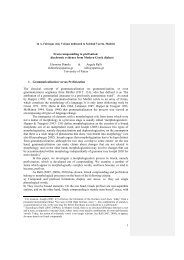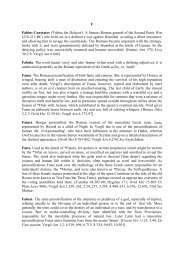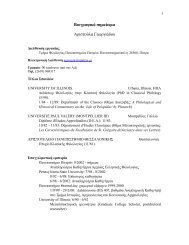Case mismatches in Greek: Evidence for the autonomy of morphology
Case mismatches in Greek: Evidence for the autonomy of morphology
Case mismatches in Greek: Evidence for the autonomy of morphology
Create successful ePaper yourself
Turn your PDF publications into a flip-book with our unique Google optimized e-Paper software.
180 manuel espaol-echevarra and angela ralli<br />
descriptions. More concretely, we argue that specication <strong>for</strong> a +/;Genitive<br />
feature is <strong>in</strong>volved <strong>in</strong> <strong>the</strong> morphological <strong>Case</strong> mark<strong>in</strong>g <strong>of</strong> <strong>Greek</strong> Nom<strong>in</strong>atives<br />
[;Genitive], Accusatives [;Genitive], and Genitives [+Genitive], and that <strong>the</strong><br />
syntactic operation <strong>of</strong> feature check<strong>in</strong>g makes use <strong>of</strong> <strong>the</strong> [+/;Genitive] feature,<br />
<strong>in</strong>stead <strong>of</strong> more ne-gra<strong>in</strong>ed features <strong>for</strong> <strong>Case</strong>, also available <strong>in</strong> <strong>the</strong> morphological<br />
feature structure. This proposal has <strong>in</strong>terest<strong>in</strong>g consequences <strong>for</strong><br />
<strong>the</strong> organization <strong>of</strong> grammar. First, it supports <strong>the</strong> view <strong>of</strong> <strong>morphology</strong> as<br />
a well-dierentiated component <strong>of</strong> grammar. Second, it assigns a signicant<br />
role to <strong>morphology</strong> <strong>in</strong> <strong>the</strong> grammar <strong>of</strong> <strong>Case</strong>, <strong>the</strong> most structurally relevant <strong>of</strong><br />
all <strong>in</strong>ectional features (as dened by Kuryowicz 1964). F<strong>in</strong>ally, <strong>the</strong> present<br />
proposal claims that syntax may have access to <strong>the</strong> morphological feature<br />
structure <strong>of</strong> lexical items. The discussion is organized as follows. Section 1<br />
conta<strong>in</strong>s <strong>the</strong> data relevant to our discussion, and deals with <strong>the</strong> <strong>the</strong>oretical<br />
consequences that <strong>the</strong> existence <strong>of</strong> <strong>Case</strong> <strong>mismatches</strong> <strong>in</strong> <strong>Greek</strong> CLLD contexts<br />
has <strong>for</strong> Baker's (1996) view <strong>of</strong> Clitic Left Dislocation. In section 2, we deal with<br />
<strong>the</strong> issue <strong>of</strong> feature match<strong>in</strong>g <strong>in</strong> CLLD cha<strong>in</strong>s, cf. 2.1, and present our analysis<br />
<strong>of</strong> <strong>Case</strong> mismatch <strong>in</strong> CLLD contexts, cf. 2.2 and 2.3. Section 3 is devoted<br />
to analyse <strong>the</strong> sort <strong>of</strong> <strong>Case</strong>-check<strong>in</strong>g operation lead<strong>in</strong>g to <strong>Case</strong> <strong>mismatches</strong><br />
<strong>in</strong> CLLD free relatives as a case <strong>of</strong> syntactic syncretism. Some conclud<strong>in</strong>g<br />
remarks <strong>in</strong> section 4 close <strong>the</strong> paper.<br />
1. <strong>Case</strong> <strong>mismatches</strong> <strong>in</strong> clitic left-dislocation constructions: <strong>the</strong> data<br />
Elaborat<strong>in</strong>g on C<strong>in</strong>que's (1990) analysis <strong>of</strong> Italian CLLD constructions, Baker<br />
(1996) claims that dislocated constituents <strong>in</strong> languages, both polysyn<strong>the</strong>tic<br />
and non-polysyn<strong>the</strong>tic, <strong>for</strong>m a non-movement cha<strong>in</strong> with a unique pronom<strong>in</strong>al<br />
<strong>in</strong> argument position. The conditions on this cha<strong>in</strong> <strong>for</strong>mation are stated as<br />
follows (cf. Baker 1996, 112):<br />
(1) The Cha<strong>in</strong> Condition<br />
XandYmay constitute a cha<strong>in</strong> only if:<br />
(i) X c-commands Y.<br />
(ii) X and Y are co<strong>in</strong>dexed.<br />
(iii)<br />
(iv)<br />
There is no barrier conta<strong>in</strong><strong>in</strong>g Y but not X<br />
X and Y are nondist<strong>in</strong>ct <strong>in</strong> morphosyntactic features (i.e., category, person,<br />
number, gender, case, etc.)<br />
Accord<strong>in</strong>g to <strong>the</strong> condition <strong>in</strong> (1iv), feature <strong>mismatches</strong> between left-dislocated<br />
constituents and <strong>the</strong> pronom<strong>in</strong>als co<strong>in</strong>dexed with <strong>the</strong>m are not allowed. Baker,<br />
Acta L<strong>in</strong>guistica Hungarica 47, 2000










